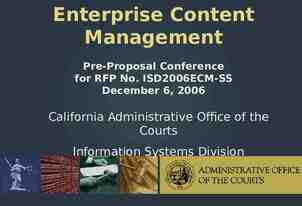SECTION 49 OF THE CRIMINAL PROCEDURE ACT, 1977: USE OF FORCE IN
21 Slides344.50 KB
SECTION 49 OF THE CRIMINAL PROCEDURE ACT, 1977: USE OF FORCE IN EFFECTING ARREST
SUMMARY The Bill aims to amend section 49 of the Criminal Procedure Act, 1977 (Act 51 of 1977), in order to bring it into line with the judgment of the Constitutional Court in the case of Ex parte: The Minister of Safety and Security and Others: In re the State v Walters and Another (2002(2) SACR 105 (CC) (Walters). The Bill strives to enhance effective law enforcement by providing greater legal certainty to arrestors as to the circumstances under which force may be applied when attempting to effect an arrest, and the nature of the force that may lawfully be used in the course of an arrest.
SECTION 49 IN CONTEXT OF CPA Chapter 5 – Arrest – sections 39 to 53 S39 – Manner and effect of arrest* S40 – Arrest by peace officer without warrant S41 – Name and address of certain persons arrest without warrant S42 – Arrest by private person without warrant* S43 – Warrant may be issued by magistrate or judge S44 – Execution of warrants S45 – Arrest on telegraphic authority S46 – Non-liability for wrongful arrest S47 – Private persons to assist in arrest when called upon* S48 – Breaking open premises for purpose of arrest S49 – Use of force in effecting arrest S50 to 53 – Procedure after arrest, offence of escaping, savings
S39: MANNER AND EFFECT OF ARREST (1) An arrest shall be effected with or without a warrant and, unless the person to be arrested submits to custody, by actually touching his body or, if the circumstances so require, by forcibly confining his body. (2) The person effecting an arrest shall, at the time of effecting the arrest or immediately after effecting the arrest, inform the arrested person of the cause of the arrest or, in the case of an arrest effected by virtue of a warrant, upon demand of the person arrested hand him a copy of the warrant. (3) The effect of an arrest shall be that the person arrested shall be in lawful custody and that he shall be detained in custody until he is lawfully discharged or released from custody.
S42: ARREST BY PRIVATE PERSON WITHOUT WARRANT (1) Any private person may without warrant arrest any person(a) who commits or attempts to commit in his presence or whom he reasonably suspects of having committed an offence referred to in Schedule 1; (b) whom he reasonably believes to have committed any offence and to be escaping from and to be freshly pursued by a person whom such private person reasonably believes to have authority to arrest that person for that offence; (c) whom he is by any law authorized to arrest without warrant in respect of any offence specified in that law; (d) whom he sees engaged in an affray. (2) Any private person who may without warrant arrest any person under subsection (1) (a) may forthwith pursue that person, and any other private person to whom the purpose of the pursuit has been made known, may join and assist therein. (3) The owner, lawful occupier or person in charge of property on or in respect of which any person is found committing any offence, and any person authorized thereto by such owner, occupier or person in charge, may without warrant arrest the person so found.
S47: PRIVATE PERSONS TO ASSIST IN ARREST WHEN CALLED UPON (1) Every male inhabitant of the Republic of an age not below sixteen and not exceeding sixty years shall, when called upon by any police official to do so, assist such police official(a) in arresting any person; (b) in detaining any person so arrested. (2) Any person who, without sufficient cause, fails to assist a police official as provided in subsection (1), shall be guilty of an offence and liable on conviction to a fine not exceeding R300 or to imprisonment for a period not exceeding three months.
OLD SECTION 49 (BEFORE ITS REPLACEMENT BY ACT 122 OF 1998) 49. (1) If any person authorised under this Act to arrest or to assist in arresting another, attempts to arrest such person and such person (a) resists the attempt and cannot be arrested without the use of force; or (b) flees when it is clear that an attempt to arrest him is being made, or resists such attempt and flees, the person so authorised may, in order to effect the arrest, use such force as may in the circumstances be reasonably necessary to overcome the resistance or to prevent the person concerned from fleeing. (2) Where the person concerned is to be arrested for an offence referred to in Schedule 1 or is to be arrested on the ground that he is reasonably suspected of having committed such an offence, and the person authorised under this Act to arrest or to assist in arresting him cannot arrest him or prevent him from fleeing by other means than by killing him, the killing shall be deemed to be justifiable homicide.
NEW (CURRENT) SECTION 49 Existing section introduced by Judicial Matters Amendment Act, 1998, but Only commenced in 2003 Main reason for delay in implementation was uncertainty within SAPS regarding interpretation and application of new section
WALTERS CASE (2002) Constitutional Court in Walters case declared (old) section 49 (2) unconstitutional and invalid Court explained purpose of section 49 and set out legal framework regarding use of force when effecting arrest
LEGAL POSITION SET OUT BY CONSTITUTIONAL COURT (1) (a) The purpose of arrest is to bring before court for trial persons suspected of having committed offences (b)Arrest is not the only means of achieving this purpose, nor always the best (c) Arrest may never be used to punish a suspect (d)Where arrest is called for, force may be used only where it is necessary in order to carry out the arrest (e) Where force is necessary, only the least degree of force reasonably necessary to carry out the arrest may be used (f) In deciding what degree of force is both reasonable and necessary, all the circumstances must be taken into account, including the threat of violence the suspect poses to the arrester or others, and the nature and circumstances of the offence the suspect is suspected of having committed; the force being proportional in all these circumstances
LEGAL POSITION SET OUT BY CONSTITUTIONAL COURT (2) (g)Shooting a suspect solely in order to carry out an arrest is permitted in very limited circumstances only (h)Ordinarily such shooting is not permitted unless the suspect poses a threat of violence to the arrester or others or is suspected on reasonable grounds of having committed a crime involving the infliction or threatened infliction of serious bodily harm and there are no other reasonable means of carrying out the arrest, whether at that time or later (i) These limitations in no way detract from the rights of an arrester attempting to carry out an arrest to kill a suspect in self-defence or in defence of any other person
PROVISIONS OF CURRENT SECTION 49 (1) Use of force in effecting arrest 49. (1) For the purposes of this section‑ (a) 'arrestor' means any person authorised under this Act to arrest or to assist in arresting a suspect; and (b) 'suspect' means any person in respect of whom an arrestor has or had a reasonable suspicion that such person is committing or has committed an offence.
PROVISIONS OF CURRENT SECTION 49 (2) (2) If any arrestor attempts to arrest a suspect and the suspect resists the attempt, or flees, or resists the attempt and flees, when it is clear that an attempt to arrest him or her is being made, and the suspect cannot be arrested without the use of force, the arrestor may, in order to effect the arrest, use such force as may be reasonably necessary and proportional in the circumstances to overcome the resistance or to prevent the suspect from fleeing: Provided that the arrestor is justified in terms of this section in using deadly force that is intended or is likely to cause death or grievous bodily harm to a suspect, only if he or she believes on reasonable grounds— (a) that the force is immediately necessary for the purposes of protecting the arrestor, any person lawfully assisting the arrestor or any other person from imminent or future death or grievous bodily harm; (b) that there is a substantial risk that the suspect will cause imminent or future death or grievous bodily harm if the arrest is delayed; or (c) that the offence for which the arrest is sought is in progress and is of a forcible and serious nature and involves the use of life threatening violence or a strong likelihood that it will cause grievous bodily harm.
PROBLEM STATEMENT RE CURRENT SECTION 49 Current section formulated in 1998, before Walters case was decided Criticised as being difficult to interpret and as equating use of force for arrest to law of self defence, leading to uncertainty among police officers regarding legitimate use of deadly force Viewed by some as narrower in application than the guidelines furnished by the Constitutional Court in Walters case since the Court made it clear that shooting to prevent a suspect from fleeing would be sanctioned if the suspect is reasonably suspected of having committed a violent offence (involving infliction of serious bodily harm)
AMENDMENT REQUESTED BY MIN OF POLICE SAPS argues that the effect of this provision is that— a police officer may not shoot at a suspected murderer or rapist (unless the police officer believes on reasonable grounds that the suspect is a serial murderer or rapist), or armed robber unless the suspect threatens the life of the police officer or another person at the time of the attempt to arrest the suspect an armed murderer or rapist who is fleeing without threatening anyone must be pursued by the police officer in order to catch up with and arrest the suspect, all the while running the risk of the suspect suddenly turning around and firing at the police officer the limitations imposed by section 49 on the use of deadly force when effecting an arrest are more restrictive than the criteria laid down by the Constitutional Court section 49 has given a "right to flee" to all those suspected criminals who are not suspected of being serial killers or rapists
AIM OF AMENDMENT Amendment aimed at aligning section 49 with wording used (criteria laid down) in Walters case Definition of “deadly force” inserted to promote clarity Paragraphs (a) to (c) of proviso replaced with wording following Walters case
AMENDMENT AS INTRODUCED INTO NA: section (49)(1) 49. (a) (b) an (c) not (1) For the purposes of this section 'arrestor' means any person authorised under this Act to arrest or to assist in arresting a suspect; [and] 'suspect' means any person in respect of whom arrestor has [or had] a reasonable suspicion that such person is committing or has committed an offence; and 'deadly force' means force that is likely to cause serious bodily harm or death and includes, but is limited to, shooting at a suspect with a firearm.
AMENDMENT AS INTRODUCED INTO NA: section (49)(2) (2) If any arrestor attempts to arrest a suspect and the suspect resists the attempt, or flees, or resists the attempt and flees, when it is clear that an attempt to arrest him or her is being made, and the suspect cannot be arrested without the use of force, the arrestor may, in order to effect the arrest, use such force as may be reasonably necessary and proportional in the circumstances to overcome the resistance or to prevent the suspect from fleeing: Provided that the arrestor [is justified in terms of this section in using deadly force that is intended or is likely to cause death or grievous bodily harm to a suspect, only if he or she believes on reasonable grounds— (a) that the force is immediately necessary for the purposes of protecting the arrestor, any person lawfully assisting the arrestor or any other person from imminent or future death or grievous bodily harm; (b) that there is a substantial risk that the suspect will cause imminent or future death or grievous bodily harm if the arrest is delayed; or (c) that the offence for which the arrest is sought is in progress and is of a forcible and serious nature and involves the use of life threatening violence or a strong likelihood that it will cause grievous bodily harm] may use deadly force only if(a) the suspect poses a threat of serious violence to the arrestor or any other person; or (b) the suspect is suspected on reasonable grounds of having committed a crime involving the infliction or threatened infliction of serious bodily harm and there are no other reasonable means of effecting the arrest, whether at that time or later.
CONCERN LEADING TO AMENDMENT BY NA During the process of deliberation by the Portfolio Committee in the NA, it emerged that some commentators on the Bill interpreted paragraphs (a) and (b) of the proviso to subsection (2) as introducing separate (and lesser) requirements for the justification of deadly force during arrest, since the main requirement of proportionality was not repeated in the proviso. The Portfolio Committee decided to amend subsection (2) in order to make it absolute clear that use of force during an arrest must at all times be reasonably necessary and proportional in the circumstances.
AMENDMENT EFFECTED TO SUBSECTION (2) (Changes to original version indicated in red text) (2) If any arrestor attempts to arrest a suspect and the suspect resists the attempt, or flees, or resists the attempt and flees, when it is clear that an attempt to arrest him or her is being made, and the suspect cannot be arrested without the use of force, the arrestor may, in order to effect the arrest, use such force as may be reasonably necessary and proportional in the circumstances to overcome the resistance or to prevent the suspect from fleeing [: Provided that the arrestor is justified in terms of this section in using deadly force that is intended or is likely to cause death or grievous bodily harm to a suspect, only if he or she believes on reasonable grounds— (a) that the force is immediately necessary for the purposes of protecting the arrestor, any person lawfully assisting the arrestor or any other person from imminent or future death or grievous bodily harm; (b) that there is a substantial risk that the suspect will cause imminent or future death or grievous bodily harm if the arrest is delayed; or (c) that the offence for which the arrest is sought is in progress and is of a forcible and serious nature and involves the use of life threatening violence or a strong likelihood that it will cause grievous bodily harm] but, in addition to the requirement that the force must be reasonably necessary and proportional in the circumstances, the arrestor may use deadly force only if(a) the suspect poses a threat of serious violence to the arrestor or any other person; or (b) the suspect is suspected on reasonable grounds of having committed a crime involving the infliction or threatened infliction of serious bodily harm and there are no other reasonable means of effecting the arrest, whether at that time or later.
END


























